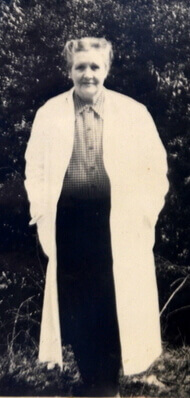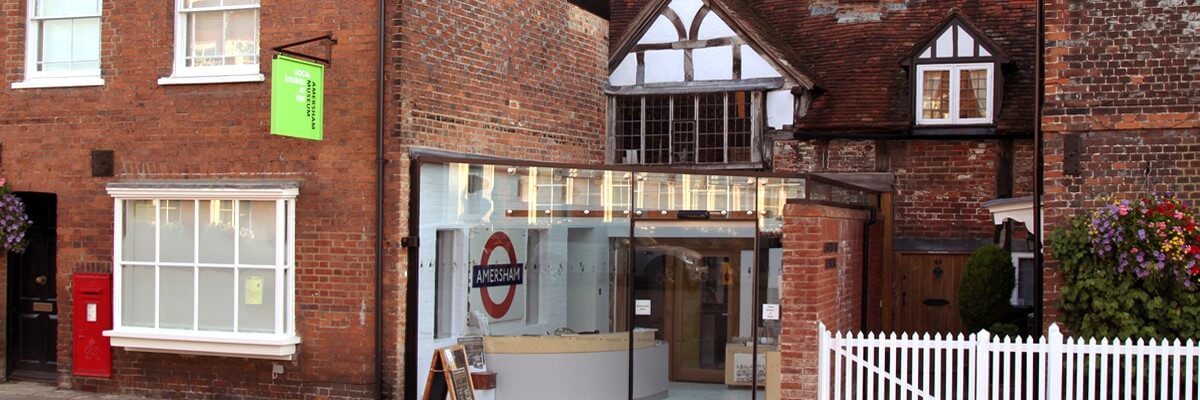Beatrice Ethel Turner
This article was written by Jane Clarke in 2018
Beatrice Turner was a high achieving woman at a time when women rarely had careers, let alone ones which resulted in them receiving national recognition. At the start of the Second World War Beatrice was asked by the Ministry of Health to establish an emergency Maternity Hospital at Shardeloes, where she served as Chief Obstetrician throughout the Second World war. She was awarded an OBE in the New Year’s Honours list in 1946 in recognition of her services.
The Early Years
Beatrice was born into a prosperous Victorian middle-class family in 1891, the second oldest of four daughters, all born within a four-year period. Her father was a well-known and eminent physician and medical administrator contributing articles to the British Medical Journal (BMJ) and serving on numerous Committees. He was a renowned orator and deeply passionate about his subject. Perhaps Beatrice inherited her talent for and love of medicine from him. Her mother had been born in India; the family lived in a fine house in Paddington with several servants. Beatrice was educated and passed her preliminary matriculation at the age of 21 in 1913.
First World War and training
During the Great War in 1915/16 Beatrice served as a nurse with the British Committee of the French Red Cross on the western front. She was mentioned in a dispatch of 7 November 1917 by Sir Douglas Haig’s (a senior officer of the British Army who commanded the British Expeditionary Force (BEF) on the Western Front from late 1915 until the end of the war). At the end of the War she was awarded a Red Cross scholarship and studied medicine at the London (Royal Free Hospital) Medical School for Women, qualifying in 1925.
The London School of Medicine for Women was set up by a group of pioneering women physicians, led by Sophia Jex-Blake, who had been expelled from Edinburgh University after beginning their medical training, together with some male doctors who supported women’s entry into the medical profession. It was the first medical school in Britain to admit women, and the only school to do so until 1886. The School opened in 1874, in a small house in Henrietta Street, off Brunswick Square. Then in 1877, an agreement was reached with the Royal Free Hospital, which allowed students at the London School of Medicine for Women to complete their clinical studies on its wards. The Royal Free Hospital was the first teaching hospital in London to admit women for training. In recognition of this relationship, in 1898 the School changed its name to The London (Royal Free Hospital) School of Medicine for Women.
Professional life
In 1925 Beatrice qualified as a Bachelor of Surgery and Medicine becoming a member of the Royal College of Surgeons (MRCS) and Licentiate of the Royal College of Physicians (LRCP). Her specialism was in obstetrics and gynaecology. In 1928 she was recognised as a Fellow of the Royal College of Surgeons and in 1939 as a Fellow of the Royal College of Gynaecologists. In the late 1920’s and 1930’s she published several papers In the Lancet and the British Medical Journal including one on “Infant mortality in the unit of the Royal Free Hospital” in 1930 (jointly with Professor Dame Louise McIlroy), and one on “The resuscitation of new born” in 1929. Beatrice was an expert in her field contributing to the reduction of infant mortality rates through her practice. Like her father before her Beatrice was a member of the British Medical Association.
Beatrice undertook her medical training working on the wards of the Royal Free Hospital in London. She went on to work as a junior assistant obstetrician at the Elizabeth Garrett Anderson Hospital (which provided health and obstetric care to women, and which continued to expand throughout this period) and as house surgeon at the cancer hospital in Fulham Road. By 1935 she was Senior Assistant Gynaecologist and Obstetrician at the Royal Free, Assistant obstetric surgeon at Elizabeth Garrett Anderson hospital and a consultant obstetrician for the Borough of High Wycombe.
Shardeloes
 At the start of the second World War Beatrice was asked by the Ministry of Health to set up an emergency maternity Hospital at Shardeloes. Beatrice served as the Chief obstetrician throughout the war at Shardeloes and oversaw the birth of more than 5000 babies, including some famous names, such as Tim Rice. There were over 48 people listed as living at the maternity Hospital during the war, including Beatrice.
At the start of the second World War Beatrice was asked by the Ministry of Health to set up an emergency maternity Hospital at Shardeloes. Beatrice served as the Chief obstetrician throughout the war at Shardeloes and oversaw the birth of more than 5000 babies, including some famous names, such as Tim Rice. There were over 48 people listed as living at the maternity Hospital during the war, including Beatrice.
The hospital mainly served mothers from London but also admitted some mothers from the local area, along with all complicated and difficult cases. The outcomes for the babies were very good, with a mortality rate of 1.67 per 1000 compared with a national rate of 2 per 1000. Unlike other maternity hospitals every patient had an anaesthetic.
There were two royal visits to the Hospital during the war- to mark the birth of the 2000th baby and of the 3000th baby. On June 26th, 1943 the hospital was visited by Queen Elizabeth and in September 1944 by Princess Elizabeth, wearing her ATS uniform. The Princess was received by Captain Tyrwhiitt Drake and his wife (the owners of Shardeloes) and Beatrice was presented to the Princess, along with members of the local Red Cross, Local Council and the Church. Beatrice is pictured standing rather stiffly next to Princess Elizabeth!
Beatrice’s success and dedication to the maternity hospital was recognised through the award of an OBE in the New Year’s honours list in 1946.
The post war years
Following the war Beatrice returned to practice medicine in London. She is listed as being the Honorary Senior obstetric surgeon with Elizabeth Garret Anderson Hospital, Honorary gynaecologist at St Mary’s Hospital in Plaistow and Bermondsey, a consultant obstetrician for the boroughs of High Wycombe and Kingston-upon Thames. She was also a Fellow of the Royal Society of Medicine.
Her qualities of exceptional leadership were recognised through some of the positions she held. She became Vice President of her section of the Royal Society of Medicine and of the Federation of Medical Women. She also was appointed Vice-Dean at the Royal Free Hospital School of Medicine for Women. Beatrice retired in 1956 at the age of 65.
The British Medical Journal notes that her outstanding qualities pertained to her courage, her ability to instil confidence in all around her – both staff and patients, – and her enjoyment of life.
Personal life
Beatrice never married and had no children of her own. Up to the age of 20 she lived at home in London with her parents. Following the First World war she lived in several addresses in north London, which were most likely Halls of residence for hospital doctors. She maintained her name on the electoral roll in north London during the second World war, even though she was living at Shardeloes. Following the war, she returned to live in northwest London until her retirement.
During the 1930’s and again after the Second World War Beatrice lived in London with another female doctor – Elaine Margaret Katherine Salmond MD (known as Margaret). She too was a notable obstetrician and gynaecologist, who was awarded an MBE for her role as medical doctor in charge at Tidworth during the second World war, and wrote a number of articles and gave lectures on the importance of women’s health. We do not know the nature of their relationship, but when Beatrice retired in 1956 she moved to the Isle of Mull, and in 1957 is joined by Miss Salmond.
Beatrice’s father died in 1931 when Beatrice was 40 and her mother 69. Beatrice’s mother moved to Willow House in the High Street in Old Amersham sometime after her husband’s death, where she remained until her death in 1946. We don’t know much about Beatrice’s sisters. Her eldest sister, Margaret, never married and went to live on the Isle of Mull. This most likely explains why Beatrice chose to retire there.
Beatrice died on Christmas Day 1964. She is described in her obituary as having many friends and being a skilled raconteur, with a keen sense of humour and excellent timing in her telling of events and stories. She had lived to be 73. Her sister had died the previous year. Margaret Salmond continued to live on the isle of Mull until her death in 1982 at the age of 85.
Pictures of Beatrice are in Shardeloes Maternity Hospital in the 1940’s

